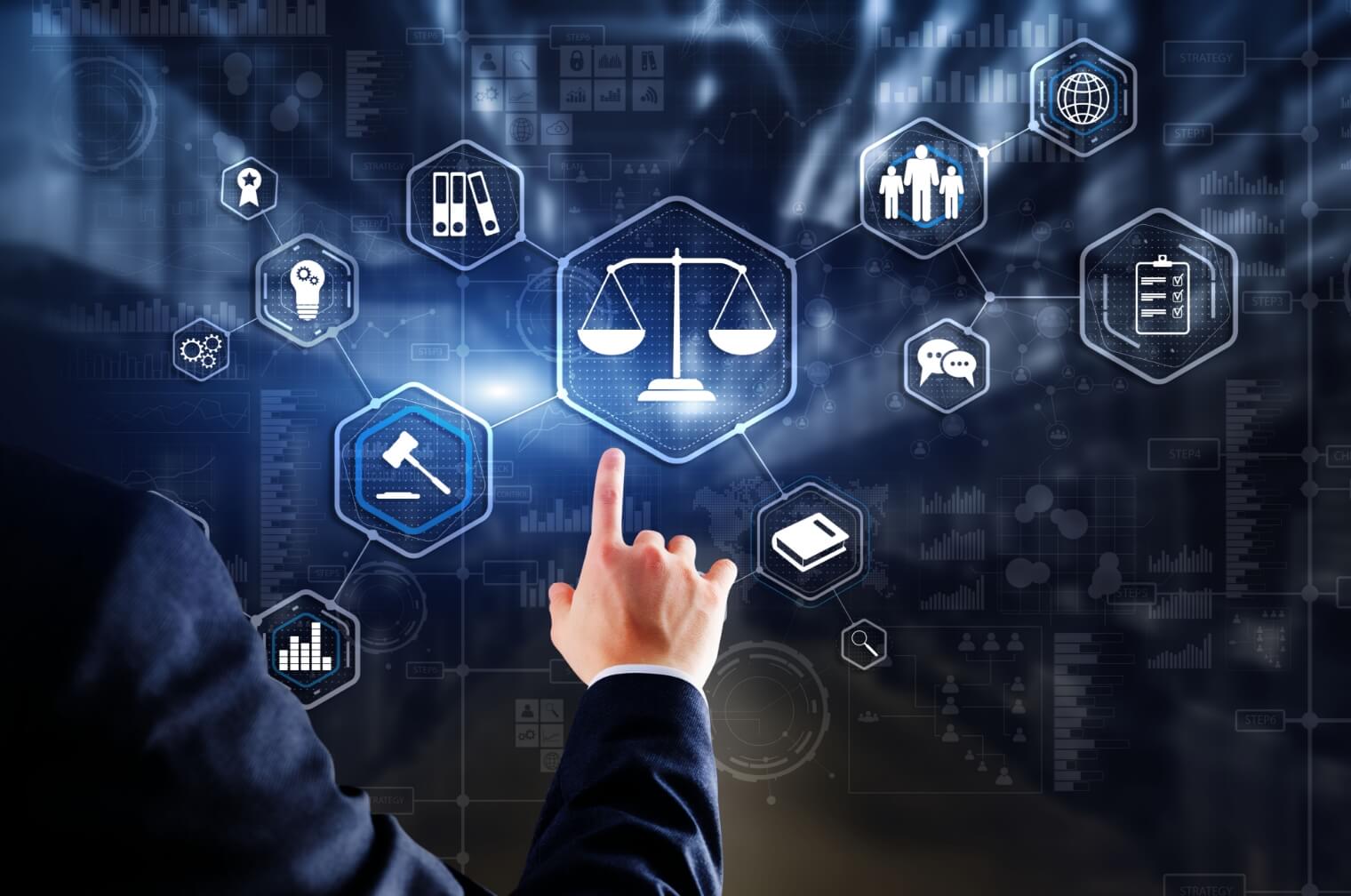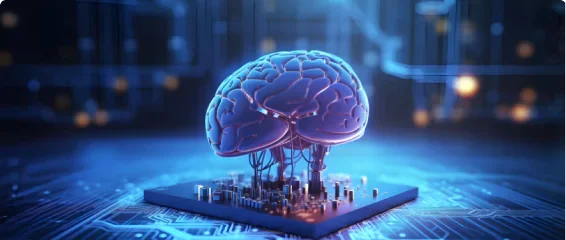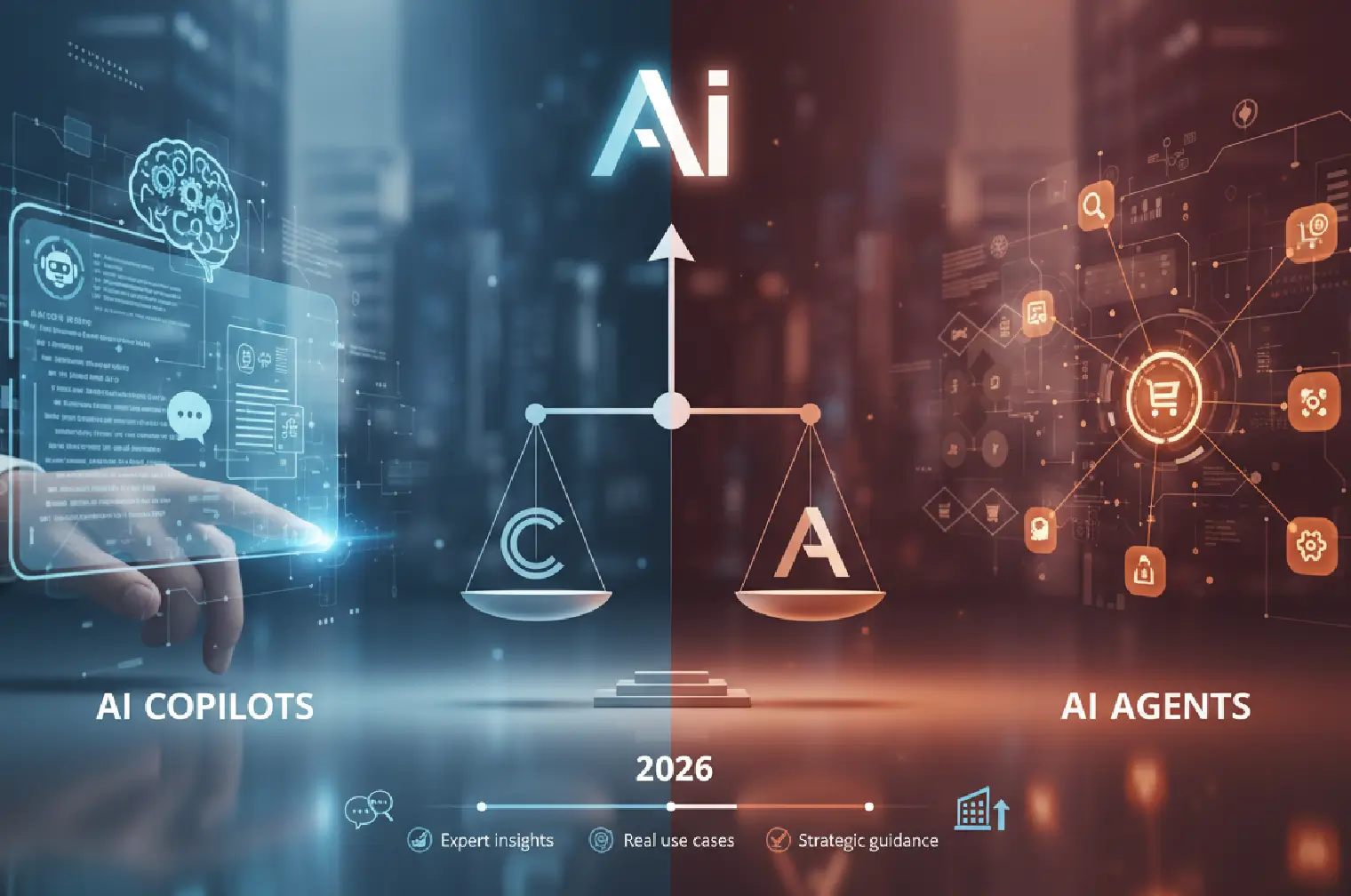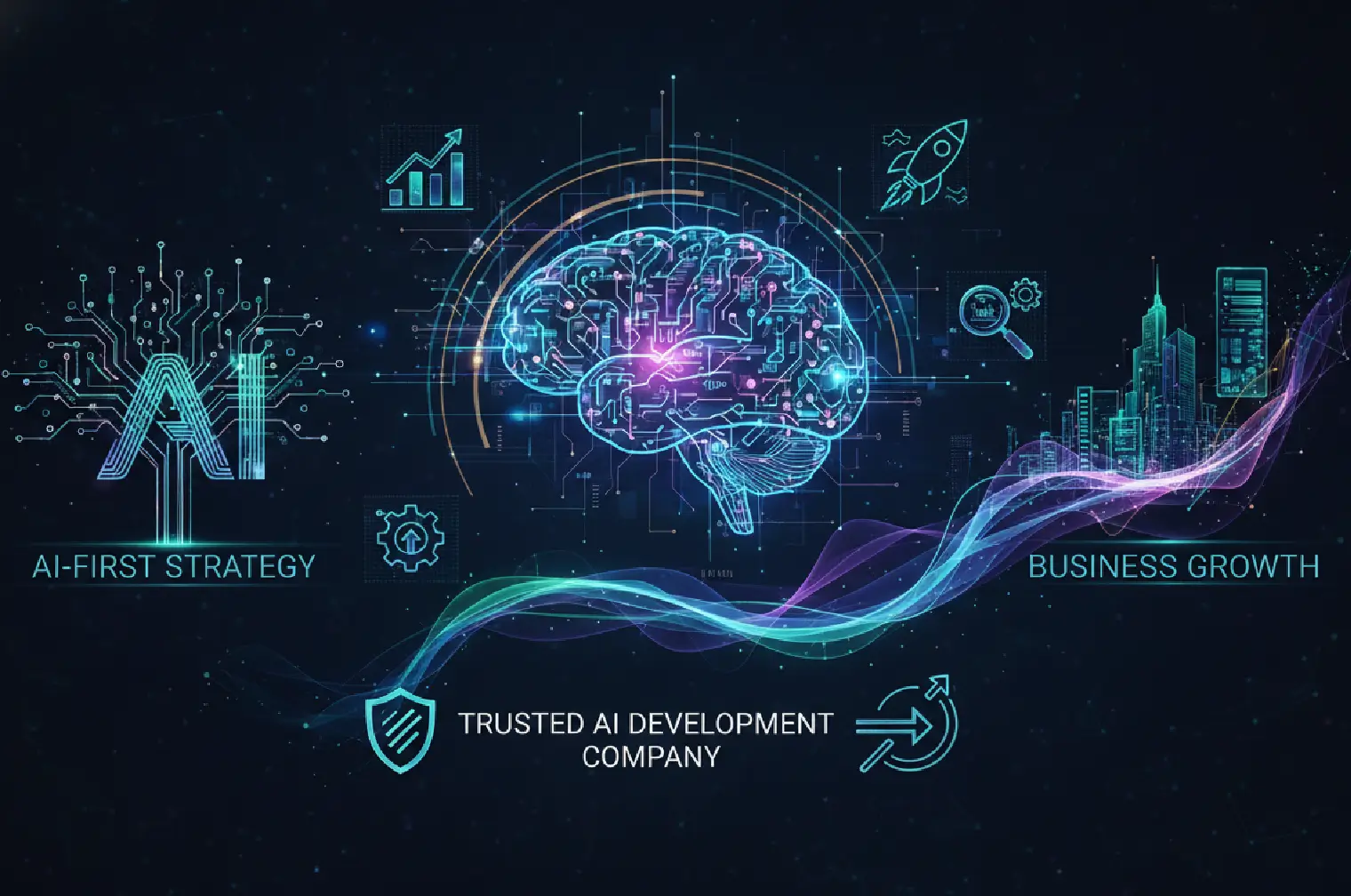Machine Learning and AI for revolution of Tech Companies are changing and streamlining businesses.
The public sector faces significant challenges like corruption, lack of transparency, and excessive paperwork. As demands for efficiency and innovation grow, artificial intelligence in the public sector is emerging as a game-changer. While some early AI projects have been introduced in specific services, many governments still grapple with fully integrating AI solutions that meet both operational needs and citizen expectations.
At ViitorCloud, we understand these challenges and offer cutting-edge AI development services designed specifically for the public sector. Whether it’s automating processes, enhancing decision-making, or increasing transparency, our AI solutions can transform how public services operate—boosting efficiency while maintaining accountability.
Governments are already investing in AI and now is the time to take the next step with a trusted partner. ViitorCloud’s AI in the public sector services is tailored to meet your unique needs, ensuring that your transition to AI is seamless and impactful.
Let us help you redefine the future of public services with AI. Get in touch today and explore how our AI development services can power your digital transformation.
What is AI in the Public Sector?
Artificial intelligence in the public sector utilization within governmental operations and services is referred to as Artificial Intelligence, which is applied to a wide range of government activities to enhance efficiency and effectiveness.
State bodies have started investing more in artificial intelligence technologies to address various issues that public organizations face.
According to a Deloitte report on AI in government:
- The majority (70%) of business leaders back up governments’ efforts towards implementing artificial intelligence projects
- By 2024, 75% of governments will have started or launched at least three enterprise-wide hyper-automation initiatives
- Digital maturity level is low at 80% among government agencies
Artificial intelligence technologies would significantly reduce labor hours spent on manual processes within government administration units, allowing employees to focus on more essential tasks and making it easier for such agencies to provide services efficiently.
Impact of AI in the Public Sector
The use of artificial intelligence in the public sector allows for the provision of personalized, efficient citizen services like automated replies to queries or predictive analytics concerning resource distribution.
When AI supports data analysis and predictive modeling, better decision-making processes through evidence-based policy formulation can be achieved. The World Health Organization (WHO) estimates that 1.3 million people die in road crashes each year. Governments can significantly enhance road safety and reduce these fatalities by utilizing AI in transportation.
AI optimizes internal processes like resource management and fraud detection, reducing costs and improving accuracy. AI has become more common in government as a way to modernize public services and respond to complex societal challenges.
Optimize Public Services with AI
Ready to streamline operations with cutting-edge AI in the public sector? Connect with our experts today!
5 ways AI is Used to Regulate the Public Sector Industry
AI is increasingly used in the public sector for better governance and regulatory practices.
This is how it works:
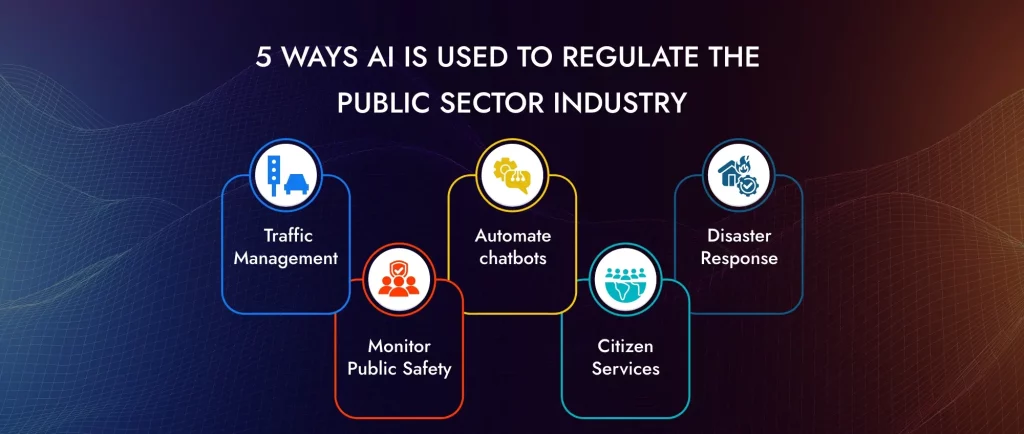
1. Traffic Management
According to the World Health Organization (WHO), about 1.3 million people die annually from road traffic crashes. Governments can significantly mitigate road safety issues by effectively employing AI in transportation.
Technological advancements such as computer vision, object detection, drone tracking, and camera-based traffic systems enable government organizations to analyze crash data and pinpoint high-risk areas. They can proactively prevent future accidents by implementing additional road safety measures based on these analyses.
Furthermore, AI and machine learning algorithms provide data-driven insights that assist officials in managing traffic flow, reducing accidents and congestion, optimizing logistics, and enhancing overall road safety.
For instance, the U.S. Department of Energy has developed the Transportation State Estimation Capability (TranSEC), an AI tool that uses machine learning to analyze traffic patterns. Even with incomplete or limited traffic data, TranSEC provides real-time street-level estimations of vehicle movements, aiding in efficient traffic management.
2. Monitor Public Safety
By leveraging advanced technologies like computer vision, predictive analytics, and machine learning, AI is crucial in public safety monitoring. These systems offer real-time surveillance, threat detection, faster response times, and safety enhancements.
AI-powered public sector cameras and drones can monitor crowd activities and notify security agencies of suspicious occurrences. Therefore, this proactive approach helps in crime prevention. By evaluating past criminal records, AI algorithms can forecast future hotspots for crime so that law enforcement agencies distribute their resources efficiently and stop crimes before they happen.
Artificial intelligence systems can track congestion patterns, identify accidents, improve traffic flow, and enhance road safety. These systems also have features that enable automated penalties against traffic offenses, hence ensuring adherence to traffic rules.
3. Automate chatbots
Every day, government officials interact with citizens, answering their questions. With the help of artificial intelligence-based chatbots, these interactions can be automated, allowing employees to work on other complicated matters.
These chatbots provide citizens with extensive knowledge, offer multilingual assistance, and collect wide-scale feedback from the population. For example, the United States Army recruitment website has a virtual assistant called SGT STAR, with which members have made more than ten million interactions with the public. It acts like a guide through its platform and answers some basic questions until it leads users toward human attendants if needed.
In the US, the Department of Homeland Security also uses an EMMA, a virtual assistant for immigration services. On average, one million applicants contact her monthly to be shown some services in this department and given links to relevant pages and resources.
4. Citizen Services
AI-powered virtual assistants and chatbots can address multiple citizen inquiries, provide government service details, and assist with complicated processes. By doing so, they reduce human employee pressure and speed up response time frames.
Additionally, AI automates routine administrative tasks, including application processing, document verification, permit issuance, etc. This speeds up service delivery and reduces the chances of errors and fraud.
5. Disaster Response
AI can predict disasters such as floods, earthquakes, and hurricanes by analyzing data from diverse sources like weather patterns, seismic activity, and social media. Early warning systems are put in place for timely evacuations and preparations that will alert authorities and people before it happens.
During an incident, AI helps allocate resources more effectively by considering real-time information to determine areas that need the most help. This way, help can be provided to reach these distressed locations faster and more efficiently.
After a disaster, AI-enabled drones and satellite imagery detect the level of damage, which is important data for rescue operations. AI also aids in mapping out affected regions and manages the coordinated response on the ground.
Transform Public Sector Efficiency with AI
Discover how AI in the public sector can boost productivity and decision-making. Get in touch for tailored solutions.
What is the Role of AI in the Public Sector Industries?
AI automates tasks like data processing and citizen interaction. AI is changing public sector industries by improving efficiency as well as service delivery.
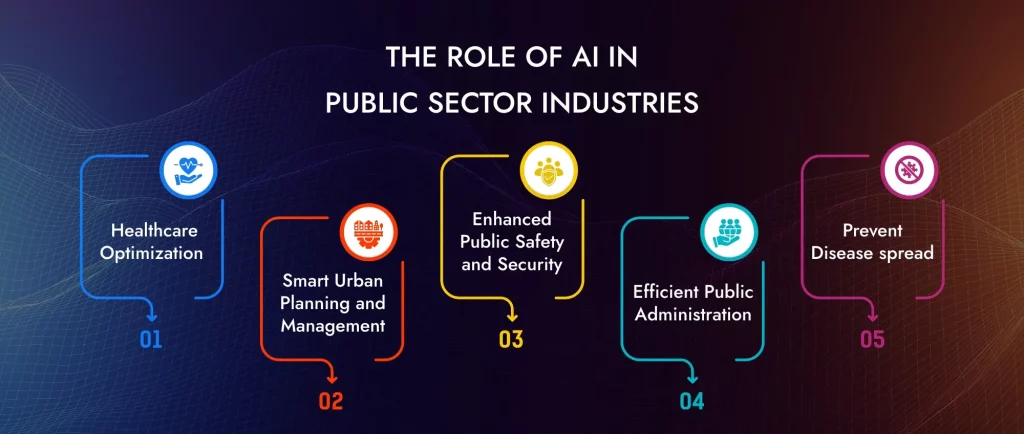
1. Healthcare Optimization
Medical science is an ever-evolving area with many opportunities for research & development. One highlighted recent Kubecon conference has been securing MLOps within the life sciences industry correctly: why?
However, artificial intelligence (AI) and machine learning (ML) have many other applications in healthcare besides this. For instance, governments can significantly improve their healthcare services using AI. Such improvements include tracking disease spread, monitoring patients’ health metrics continuously, and optimizing medicine planning and distribution.
These projects often involve working with highly sensitive content. Consequently, securing all artifacts ensures compliance standards are met while allowing multi-tenancy capabilities is important. There are abundant numerical figures available for AI/ML algorithms, including medical images, sensors, etc.
Some notable outcomes include:
- Early detection of diseases via advanced analysis of medical images
- Improved management of patient records through utilization of historical data insights
- Facilitation of robot-assisted surgeries aimed at better precision and outcomes
2. Smart Urban Planning and Management
Urban planning & management today benefit greatly from AI, making cities more efficient, sustainable, and livable. Urban planners can make informed decisions to improve the quality of life with the help of AI-powered tools.
Smart cities use AI to optimize their consumption and manage resources like water, power, or waste. Sensors and IoT devices gather data, which is then optimized to reduce wastage through AI algorithms.
AI-driven simulations, in addition to predictive modeling, assist planners in developing infrastructure that meets the needs of a growing population. This involves optimizing the placement of utilities, public services, and green spaces.
3. Enhanced Public Safety and Security
Real-time computer vision and pattern recognition enable AI-powered surveillance systems to detect suspicious activities and potential threats. This helps prevent criminal activities by detecting them before they occur.
AI algorithms can identify patterns from historical crime data and predict future crime hotspots. In this way, law enforcement agencies can deploy resources strategically, thereby preventing crimes before they happen and improving community safety.
4. Efficient Public Administration
Citizens can access information and services via AI chatbots or virtual assistants. Such tools can handle a variety of queries – from questions about public services to guiding users through application processes – thus enhancing the user experience as a whole.
That aside, AI allows governments to generate decisions by analyzing large volumes of data for trends and insights. This helps in policy development, resource allocation, and performance evaluation to ensure public services are delivered effectively and efficiently.
5. Prevent Disease spread
AI in healthcare has made remarkable strides in medical science, ranging from early detection of diseases to prevention and clinical decision support.
Real-time monitoring of patients’ health is done by artificial intelligence, which tracks their weight, height, blood sugar levels, stress levels, and heart rate. Such information is then fed into an artificial intelligence healthcare system, which informs doctors about potential risks.
Governments can utilize AI to enhance public health services. For example, AI was crucial in detecting and controlling the COVID-19 virus during the pandemic. The NHS has developed an AI tool that can detect heart disease in just 20 seconds while the patient is still in an MRI scanner, a process that would typically take a doctor 13 minutes or more to analyze manually.
The U.S. Centers for Disease Control and Prevention (CDC) uses AI to streamline poliovirus tracking and reporting. This tool identifies virus types and clusters disease reports.
Empower Your Public Services with AI
Explore AI’s impact on the public sector. Partner with ViitorCloud for seamless AI integration.
How to ViitorCloud Implement AI Solutions in the Public Sector?
Implementing artificial intelligence in the public sector requires more than just technology—it demands a tailored approach that aligns with your unique challenges and goals. At ViitorCloud, we offer comprehensive AI solutions that help you streamline operations, improve services, and deliver impactful results for citizens.
Here’s how ViitorCloud can lead your organization toward AI success:
- Identify and solve key challenges: From optimizing administrative tasks to enhancing traffic management, ViitorCloud works closely with you to pinpoint specific problems that AI in the public sector can solve, such as boosting public health initiatives or streamlining service delivery.
- Engage the right decision-makers: With our expertise in public sector collaborations, we help you bring together government officials, department heads, and policymakers to ensure full alignment and secure necessary buy-in for your AI initiatives.
- Tailored AI technologies: Whether it’s machine learning, natural language processing, computer vision, or robotic automation, we design custom solutions to fit your organization’s objectives. ViitorCloud delivers cutting-edge AI tools to drive the outcomes that matter most.
Partner with ViitorCloud to implement transformative AI public sector solutions that deliver measurable results. Let’s discuss how we can bring your vision to life and make your organization a leader in the future of public services.
Ready to transform your public sector operations with AI? Contact ViitorCloud today!
Future of AI in the Public Sector Industry
The future of AI in the public sector looks quite promising, thereby giving rise to transformative AI public sector solutions towards long-standing hurdles within this domain. Nevertheless, this journey is challenging. Public organizations need help with dealing with legacy systems and addressing data paucity. However, robotic process automation (RPA), computer vision, and natural language processing (NLP) are innovations that will make the department efficient and responsive.
So far, this has limited how much the wider corporate world has been able to adopt artificial intelligence and machine learning. However, RPA has changed everything about government paperwork handling by enabling digitization and automating repetitive tasks. This has led to efficiency in operations, thereby releasing major resources for superior strategic initiatives.
Public sector organizations can also benefit from NLP and computer vision. Where textual data is concerned, the AI public sector technology of NLP assists in extracting large volumes of such materials, while computer vision can interpret visual information from sources like surveillance cameras and medical imaging. The use of AI in the public sector industry is important as it helps to recognize patterns dealing with climate change and public health and predict and mitigate potential crises accordingly.
Redefine Public Sector Operations through AI
Learn how AI in the public sector drives innovation. Let us help you implement the right solutions.
Transform Your Public Sector with ViitorCloud’s Cutting-Edge AI Solutions
In today’s fast-paced world, leveraging artificial intelligence in the public sector is no longer optional—it’s essential. At ViitorCloud, we deliver transformative AI development services that enhance efficiency, streamline service delivery, and make data-driven decisions a reality. From smart urban planning to improved public safety, our AI solutions offer innovative ways to tackle longstanding challenges.
ViitorCloud is at the forefront of reshaping government processes with AI. Our advanced predictive tools empower law enforcement agencies to monitor and respond to potential threats in real-time, boosting community safety and reducing crime rates. With our AI-powered systems, you can elevate your operations, improve public administration, and ensure your city thrives in a digital-first world.
Partner with ViitorCloud to lead the change. Our AI expertise is the key to unlocking smarter, safer, and more efficient public sector services.
Ready to transform? Let ViitorCloud’s AI solutions power your public sector success.
Frequently Asked Questions
AI automates tasks, enhances decision-making, improves service delivery, and tackles complex issues such as healthcare access or transportation logistics using data analysis and predictive modeling.
AI in the public sector helps streamline its activities, boost efficiency, eliminate human errors, enhance the allocation of resources, and provide better services through the analysis of data as well as automated operations.
Through repetitive task automation, accuracy minimization, resource utilization optimization, and operational efficiency improvement, AI cuts down on expenses so that employees in public sectors may perform more crucial or even intricate work.
Yes, AI in the public sector can be safe if implemented with proper data security measures, ethical guidelines, and continuous monitoring to ensure compliance with regulations and protect sensitive information.




